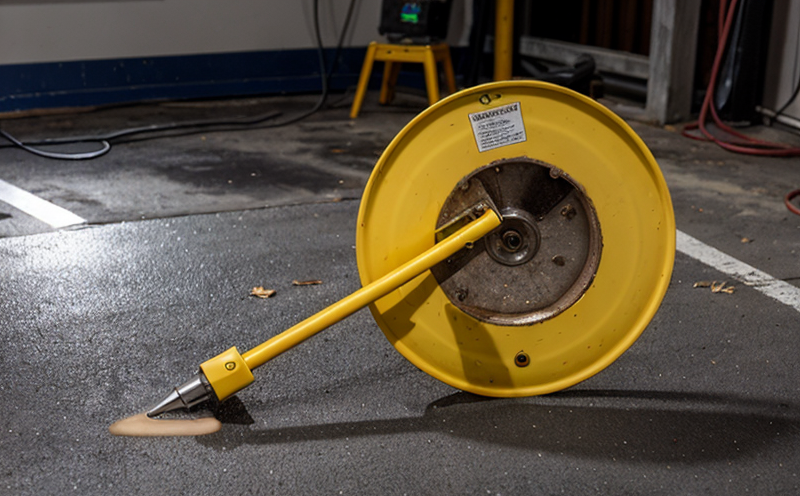ISO 16809 Ultrasonic Thickness Measurement Testing
The ISO 16809 standard outlines a method for ultrasonic thickness measurement specifically designed to evaluate the thickness of metallic materials. This non-destructive testing (NDT) technique is critical in ensuring product quality and safety, particularly in sectors such as aerospace, automotive, and manufacturing where precision and reliability are paramount.
Ultrasonic testing works by transmitting high-frequency sound waves through a material. The sound wave travels into the material until it reaches an interface or defect. By measuring the time taken for the wave to pass through the material and reflect back, we can accurately determine the thickness of the material without causing any damage.
For this method to be effective, proper specimen preparation is essential. Specimens must be clean and free from surface contaminants to ensure accurate readings. The ultrasonic probe should be applied directly to the surface being tested, with sufficient coupling fluid to eliminate air gaps between the probe and the material. This ensures that the sound waves travel efficiently into the material.
The equipment used for ISO 16809 testing includes specialized ultrasonic thickness gauges that can generate and receive ultrasonic signals. These devices are capable of adjusting settings such as frequency, coupling fluid type, and measurement range based on the specific requirements of the test specimen. The standard specifies acceptance criteria for both qualified and unqualified readings to ensure consistency across tests.
The process involves several steps. First, the operator must calibrate the equipment using a reference block with known thickness. This step ensures that all subsequent measurements are accurate. Next, the probe is placed on the surface of the specimen, and the instrument displays the thickness reading. If multiple readings are required, these should be averaged to provide an overall measurement.
The data collected during this process can then be used for various purposes including quality control, material characterization, and compliance with regulatory requirements. For instance, in aerospace manufacturing, ensuring that parts meet specific thickness specifications is crucial for maintaining safety standards.
In summary, ISO 16809 ultrasonic thickness measurement testing provides a reliable method for evaluating the integrity of metallic materials. Its non-destructive nature makes it particularly valuable in industries where material degradation could lead to significant risks or costs.
Industry Applications
| Industry Sector | Application |
|---|---|
| Aerospace | Ensuring compliance with thickness specifications for critical components like turbine blades. |
| Automotive | Quality control of engine block and cylinder head manufacturing processes. |
| Manufacturing | Maintaining consistent production standards across various metalworking operations. |
| Nuclear Power | Monitoring reactor vessel integrity for safety and regulatory compliance. |
The versatility of this testing method allows it to be applied in numerous industrial settings, making it an indispensable tool for maintaining high standards of quality control and ensuring material reliability.
Customer Impact and Satisfaction
- Enhanced safety by ensuring compliance with thickness specifications.
- Increased efficiency through accurate and reliable measurements.
- Better decision-making capabilities due to comprehensive data collection.
- Cost savings from reduced rework and material wastage.
- Improved reputation among clients and stakeholders due to consistent quality assurance.
- Streamlined compliance processes with clear documentation of test results.
By leveraging ISO 16809 ultrasonic thickness measurement testing, customers gain peace of mind knowing that their products meet the highest standards. This not only enhances customer satisfaction but also fosters long-term business relationships built on trust and reliability.
Environmental and Sustainability Contributions
ISO 16809 ultrasonic thickness measurement testing supports sustainability initiatives by promoting efficient use of materials and reducing waste. By ensuring that parts are manufactured to precise specifications, the risk of material overuse or underutilization is minimized. This leads to lower production costs and reduced environmental impact.
The non-destructive nature of this method also means that it can be used repeatedly on the same part without causing any damage, further extending the useful life of materials and reducing waste. Additionally, by detecting defects early in the manufacturing process, potential failures are avoided, preventing costly repairs or replacements later down the line.
Compliance with ISO 16809 standards is essential for many industries that must adhere to strict environmental regulations. By adopting this testing method, companies can demonstrate their commitment to sustainable practices and improve their overall environmental footprint.





